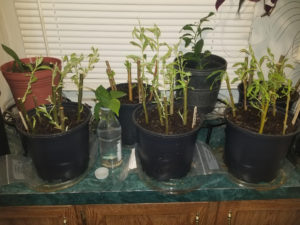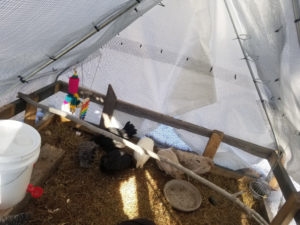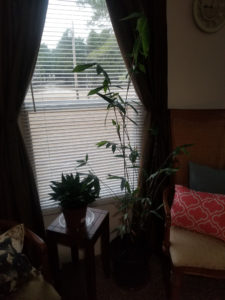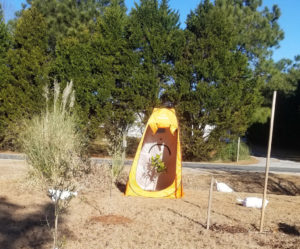At the end of 2019, I purchased a home on 1.3 acres in Greenville, NC. Since Barbie is attending graduate school at ECU, we had been paying rent for a townhouse near the college. This new home only moved us 10 minutes further from the school and the mortgage was only $50 more than our rent. By the time Barbie is done with her degree, we will have this property paid in full. Therefore, it was an easy decision to buy this home.
When we bought the property, I was excited to stock the pond and put a garden in the back yard. The deal closed in December of 2019 and I began moving ahead with my plans for the pond and the garden. Then, in March of 2020 the rest of the world collectively decided to get into gardening as a response to the pandemic and COVID-19 restrictions.
The garden I am creating is built on a foundation of perennial plants with a focus on developing complimentary system through permaculture. Everything is designed in the most sustainable organic way that I can. The goal is to create a system that requires very little effort and input to maintain.
2020 Gardening
For me, there was already a plan to develop a permaculture garden on this new property. However, the rate of development did change drastically in 2020. My original plan was to start with two or three raised beds and expand the garden if those did well. By March, that plan was expanded into a 25' x 30' fenced garden area with nine raised beds and a perennial asparagus row.
By the end of 2020, I had also added quite a few other elements to the property. These had been planned to take three of four years to establish, but they were all brought onto the property during our first year here. Originally, the property came with a pear tree which is still on the property. Today, we also have:
- three varieties of blueberries along a hedge row by the road
- thirteen Russian Comfrey
- an orange tree
- strawberries
- three varieties of olive trees
- a key lime tree
- three varieties of asparagus divided between two beds
- five varieties of mushrooms
- six trifoliate orange trees
- a stocked pond with 100 catfish, 20 bass, and countless bream
- eight chickens (arrived in January of 2021, but the process of getting them started in December)
2021 Gardening
As I am preparing for spring planting, I have a lot of work that will need to be done in the annual garden. Last year, the pandemic gardeners caused a shortage of seeds everywhere. To better prepare for this year, I have saved some seed from my previous garden. Also, I have been ordering seeds throughout the year so I have a significant stock of seeds already in storage.
In the coming weeks, I will be receiving the plants that I ordered over the winter. Additionally, I have some plants that already came in which are spending the winter indoors before they will be transplanted in the spring. These include:
- 28 willow trees which will create a living fence (five varieties)
- Bambusa Oldhamii Giant Timber clumping bamboo
- five more blueberry bushes (Pink Lemonade, Bluejay, Blueray, Coville, Herbert)
- six varieties of garlic (Early Italian Purple, Silver Rose, Inchelium Red, Italian Late, Nootka Rose, Elephant)
- Roselle Hibiscus Sabdariffa
- Sweet Leaf Stevia
- three varieties of mint (Peppermint Chocolate, Pineapple, Orange)
- Arp Rosemary
- butterfly bushes
- wildflowers for the drainage ditch along the road
- three varieties of grapes (Mars, Reliance, Marquis)
- four varieties of raspberry (Heritage, Fall Gold, Killarney, Jewel)
- one Columbia Giant Blackberry
- seventy-five more strawberry plants from three varieties (Earliglow, Sweet Kiss, AC Wendy)
- one Olympian Fig tree
Chicken Tractor
This year, the chickens are spending two weeks on each section of the garden in their 6' by 6' chicken tractor. They will scratch the soil, pull up weeds, and spread their fertilizer. To begin with, they will be working the area inside the fenced garden so it will be ready for spring.
After the fenced garden area is transitioned over to spring planting, the chickens will start working on the grass outside the fenced garden area. I have plans to triple the size of the garden, and the chickens will do the work of pulling up all the grass in that area. As they complete a section, I will release some worms in that spot and cover it with mulch. This will take the chickens several months to complete, but they can work on this while I am working in other parts of the garden.
Vermicomposting
When we first moved to this property, I started a vermicomposting system with two containers of worms from the local pet food store. Over the past year, I have released hundreds of worms from this system into my garden. Now, the population is large enough that I am starting to move worm castings leachate into the garden for fertilizer. When the chicken tractor is moved, I am adding a small scoop of worm castings and a few dozen worms to the area the chickens just worked. Then, I cover the area with pine needles to protect the worms and suppress weed growth. Later, I will pull back the pine needles to plant my garden.
Starting Seeds
One of my biggest projects for the month of February is to setup my seed starting station. I have the grow lights, shelves, trays, and a timer. Now, I just need to clean out a space and put all this together. I'm already a week or two behind for starting kale and lettuce, but I can get this done in time to catch up with the rest of the plants for this spring.
Growing Timber
Since I have several construction projects for the garden, I have added a couple sources of material into the garden design. First, there is the living willow fence. Then, there is the clumping timber bamboo which is spending the winter in my home before being transplanted in the spring.
The willow fence will provide habitat for birds, flowers for pollinators, and inputs for various garden projects. Obviously, the willow can be used to make baskets for harvesting and other uses around the property. In addition, this can be used to make garden structures or burned to produce biochar.
The timber bamboo will grow up to 4" in diameter and 40' in length. This is ample for future chicken tractors, fencing, and other garden structures. By selecting a clumping bamboo I don't have to worry about it overtaking a large portion of the property the way that running bamboo can.
Citrus
When I was in Asheville in 2019, I purchased six trifoliate orange trees. The plan is to use these for root stock to grow citrus in this region. Greenville, NC is in USDA hardiness zone 8a. There are cold hardy varieties of citrus which can survive in this zone. Additionally, grafting trifoliate orange rootstock onto other citrus varieties can improve the cold hardiness of the tree.
Grafting
I started grafting one of the Bradford Pear trees on my property in 2020 as a test and for practice. My goal is to eventually have a row of trees with multiple varieties of fruit on each tree. Since learning about the "Tree of 40 Fruit" which was made popular by Van Aken, I have added this to my list of gardening goals. During the first year, it appeared that half of my grafts survived. However, I am waiting for this spring to see the results of this first grafting attempt so I will know which grafts survived the winter. I have an orange tree which will form the foundation of my grafted citrus tree. Since this is the first winter for this tree in this location, I am using a portable shower tent to protect it while it becomes established.



